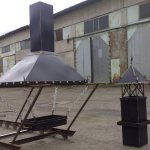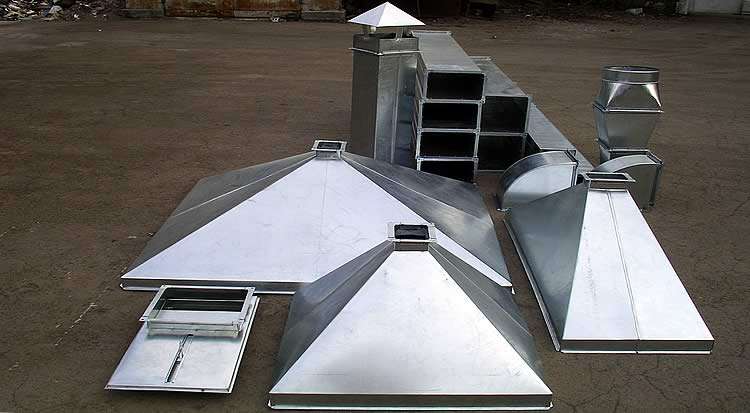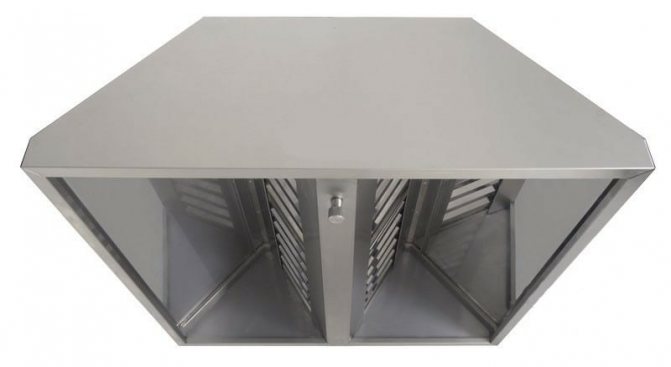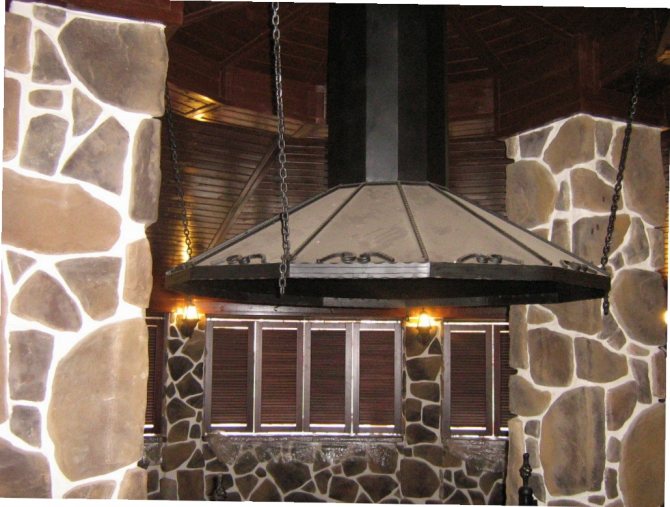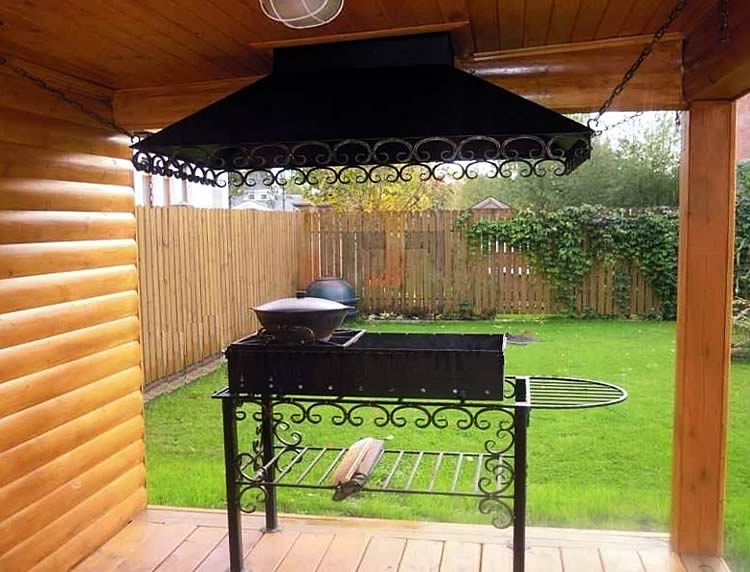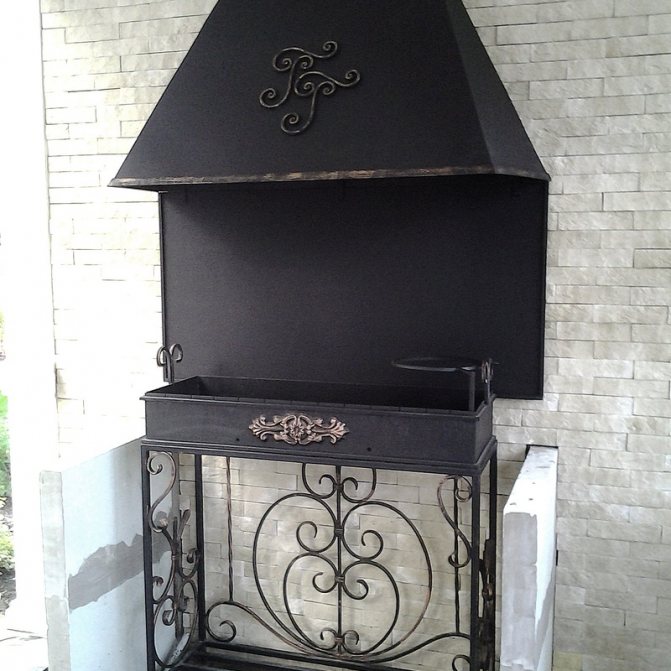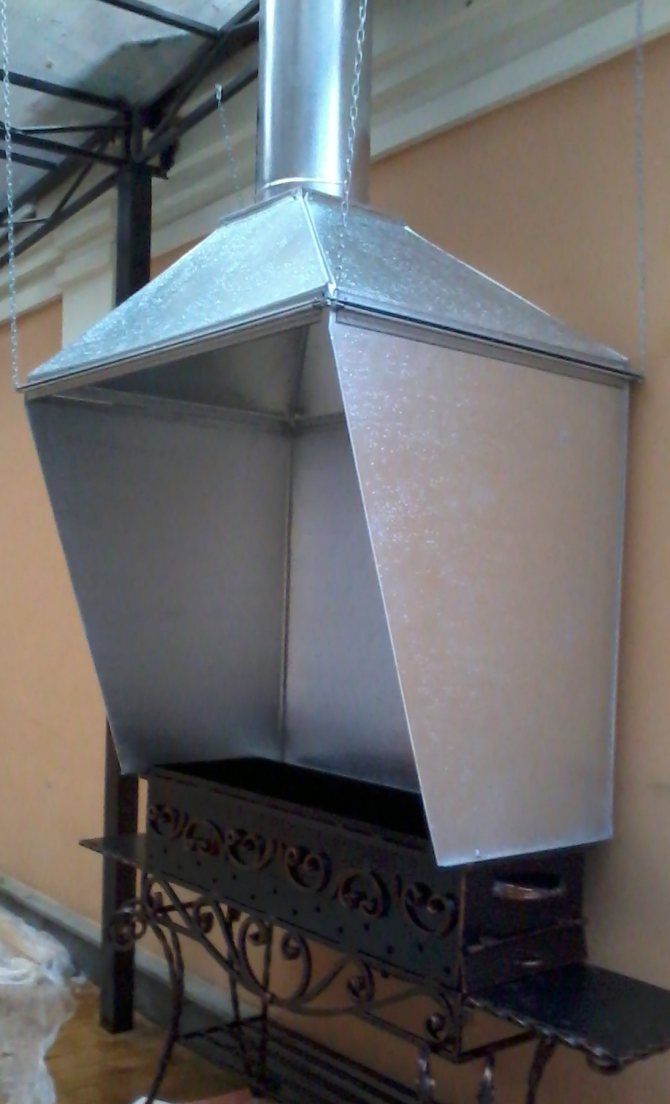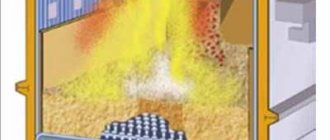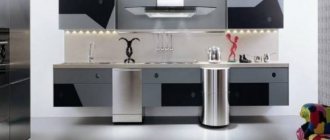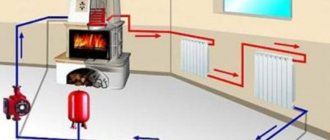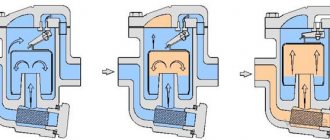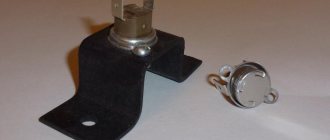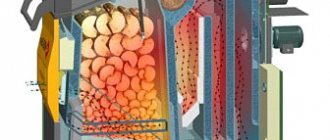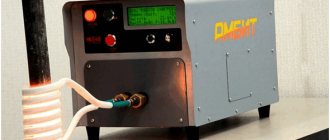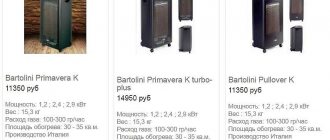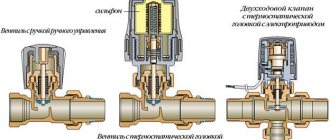Specifics
The main aspect that should be taken into account is this: the hood of the hood necessarily surpasses the area of the equipment above which it is located. This way the smoke is collected much more efficiently. The chimney should have a narrowing and a bend. This improves the dynamics of the extraction of combustion products and does not produce reverse thrust. The top side of the pipe is usually positioned at least 3 m from the ground. This provides the required exhaust conditions. If the calculation is incorrect, the chimney cross-section results in an ineffective discharge of the combustion results.
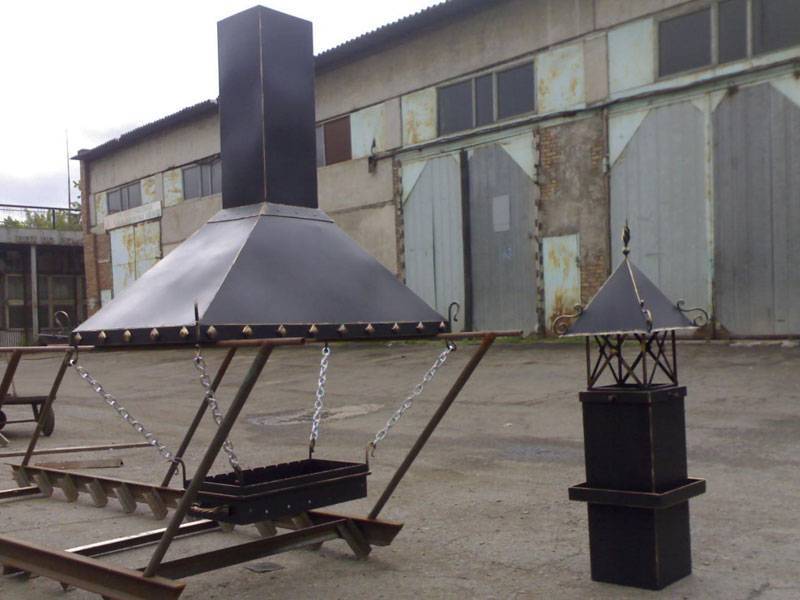
Each owner is especially proud when, by his efforts, he creates both a brazier and an extractor hood for him.
Thanks to additional components, the extraction efficiency is developed. But this requires additional costs. These components are:
Spark extinguisher. The position is the top of the chimney. This is a tubular metal sieve. Smoke easily flows through it and sparks are extinguished. Fat trap. This frame with an inserted special cassette (cassette - replaceable) for capturing fat. When this device becomes dirty, it needs to be rinsed well or replaced altogether.
It is important here how the model is delivered, what filtering substance is involved. Fan
It seriously develops pulling power. When installing it, it is necessary to make competent calculations with the parameter of the required equipment.
Independent production of an exhaust hood
Before approaching the issue of manufacturing, you should understand the features of this design.
- The hood of the hood should be larger than the surface area itself, over which it will be mounted. This will increase the productivity of collecting fumes and smoke.
- The chimney must be made with bends and contractions, due to which the speed of the exhaust process will increase and the likelihood of back draft will be excluded.
- The part of the pipe located at the top must be made at a distance of at least 3 m from the surface of the earth, which will provide excellent conditions for the operation of the exhaust system.
- It is also important to make the correct calculations when determining the cross-section of the chimney pipe. A calculation error can lead to system inefficiency.
Let's move on to building our brick exhaust hood. The base for this structure will be a frame made of corners, which should be attached to the back of the grill. The first brick layer is laid perpendicular to the wall, and the subsequent ones are laid parallel.
Laying follows tapering ledges towards the top of the structure. Basically, a brick structure for barbecues is made of about 10 rows, but the last layer must be made of the same size with the chimney hole. The size of the chimney opening can be changed using a special valve. Above the hole itself, it would be wise to build a visor.
For the construction of such a structure, it is necessary to carefully approach the choice of building material, high-quality bricks. It must be fireproof and withstand frequent temperature changes. Special oven brick - ideal for all requirements. The solution for creating the chimney must be made in the recommended proportion of sand and clay 3: 7.
An exhaust hood for a barbecue can serve you for a long time, for this it is better to take a mortar from refractory clay. All materials should be thoroughly mixed until a homogeneous consistency is formed.
Then you can start laying, it should be noted that the mortar should not roll, but ideally lie on the surface of the building material used.
Do-it-yourself metal version
The metal structure is an exhaust hood, the operating principle of which is extremely simple. It collects combustion products and removes them through a pipe from the room. Such an umbrella must be very smooth, as any roughness will reduce its effectiveness. If you prefer a metal umbrella, you must also provide a wide opening.
To make it, you will need a sheet of steel, corners (made of metal), a riveter, rivets, screws, a welding machine, a grinder and a drill.
Now for how to do it:
- The first step is to create a drawing and apply all the dimensions on which the hood will be designed.
- Now we make the frame. First, blanks of the required length are cut from metal corners. We alternately weld the lower and upper parts of the frame, and then we connect them into one structure.
- The frame of the chimney itself is assembled from the corners.
- Treat the seams left after welding. They are polished with a disc, and on top are coated with a special varnish against metal corrosion.
- Let's start covering the finished frame. We cut out metal sheets and make folds, having previously laid the sheets on the workbench.
- We use a drill and make mounting holes to securely fix the skin.
- Finally, a riveter will help sheathe the frame with sheets of metal.
- The final touch is the application of an anti-corrosion coating to extend the life of your structure.
Many are interested in how such a hood is attached. This can be done either with racks or with suspensions. The former are made of brick or iron. You can also add an interesting iron element - massive chains on which the hood will be mounted.
How to make a metal hood with your own hands
Making a metal hood is a simpler task than creating a brick system, so most summer residents choose it. In order to implement our plans and achieve the maximum functionality of a home-made chimney, you should choose the right materials, calculate the most suitable dimensions for the structure and adhere to a clear sequence of the assembly being performed. Each of these stages always has certain characteristics.
Required materials and tools
To organize a metal hood over the barbecue, most of the constituent elements can be found at home, however, as well as the tools used in the work.
We advise you to learn how to create a fireplace in landscaping.
In this case, you will need:
- sheet of metal, 3 mm thick;
- metal corners (profile), dimensions 20 × 20 × 3 mm (height / width / thickness);
- rivets, screws and heat-resistant paint (it is advisable to choose products with a maximum heat resistance level, for example, up to + 600 ° C);
- a device for welding, electrodes to it and a mask.
- drill with attachments for working with concrete;
- riveter.
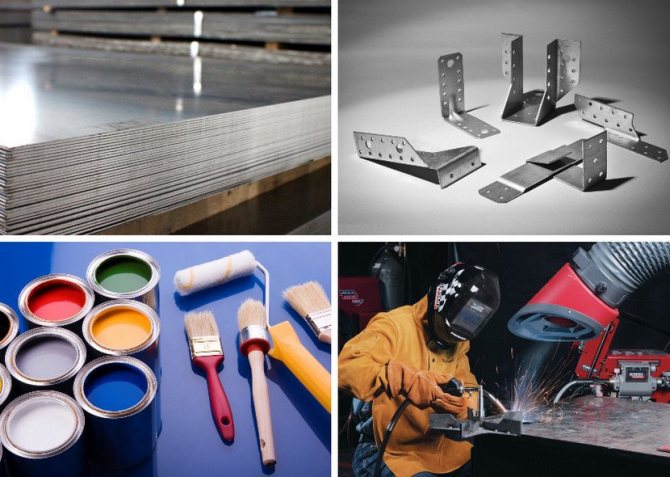

Drawing creation
The metal exhaust system includes several main components, the dimensions of which depend on the parameters of the barbecue itself. For example, for standard designs with parameters 105 × 60 cm, the distance to the top of the hood should be at least 2 m, while the width of the umbrella is determined by the size of the barbecue. If in your case the indicated base values are different, then it is worth adjusting the dimensions of the hood for them. This applies not only to the frame (attached directly to the brazier), but also to the domes located on it with an internal lintel and a chimney.
Did you know? According to the ancient Chinese teachings of Feng Shui, the best place to install a gazebo on the site is in the southwestern part of the territory, where, according to beliefs, the marriage and family zone is located.If you plant any yellow flowers (for example, sunflowers, yellow-orange irises) next to the gazebo, they will bring even more positive energy, protecting you from the "evil eye".
Step-by-step manufacturing
The process of manufacturing a metal hood for a barbecue consists of three main stages: the construction of a frame base, sheathing of the walls and installation of the upper "umbrella". Before starting the work, it is advisable to wipe the prepared metal parts with a rag from the factory grease and, if necessary, go through the grinder, removing burrs and sharp edges formed when cutting metal sheets.
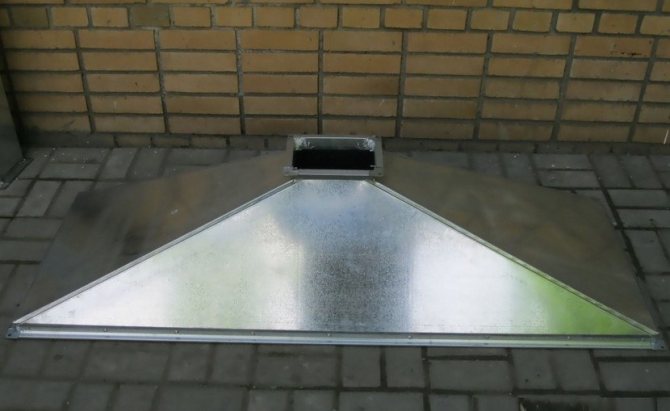

Assembling the frame
After preparing all the elements necessary for the frame, the further process of creating the support base involves the following:
- First, weld the side parts of the base of the future hood from metal corners and profile 2, and then weld more parts to them to attach the rear surface of the brazier base (you should get a U-shaped connection).
- Collect from the corners the lower part of the dome for the future hood of the hood, welding 4 parts (profiles) to each other to make a frame 1 m long and 55 cm wide (suitable for a 105 × 60 barbecue). Weld 11-centimeter pieces from the same profile to the corners of the resulting part, and on top of them install another frame, still using welding for fastening.
- Weld a profile to the corners of the resulting rectangular frame parallelepiped for attaching the back of the brazier dome. New corners of 63.5 cm should be located at a slight slope in relation to each other, forming a narrowing of the dome. The height from the middle of the parallelepiped to the end of the protruding part of the profile should be 51.5 cm.
- With the same slope of the corners, weld two other support profiles so that 2 trapezoids are already obtained on the frame.
- Make a 31 × 31 cm square frame from the remaining corner and weld it to the upper parts of the trapezoid, thereby holding the entire structure together.
- Attach 4 more vertical sections of the profile, each 56 cm long, to the corners of the resulting square part, and then fix them together with a second square frame 31 × 31 cm.Thus, you will get the exhaust pipe of the ventilation system.
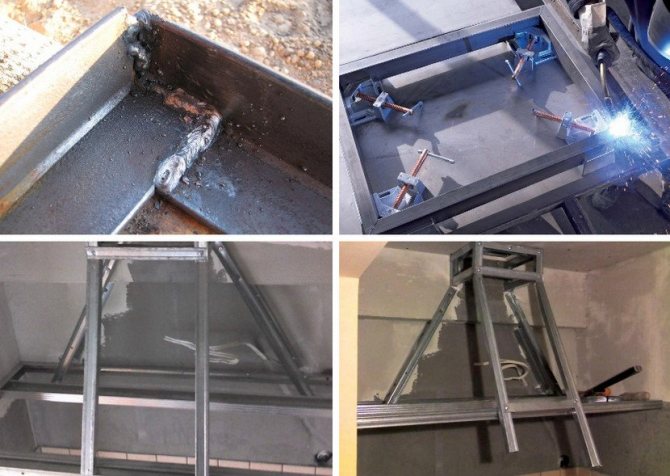

Having brought together all the details of the frame structure, clean all the seams well with a grinder and process the metal with heat-resistant paint.
Sheathing and installation of the structure
Once the metal frame is ready, all that remains is to sheathe it with sheet metal.
Important! It is better to check the strength of the welds already at the first stage of design, because in the case of poor-quality welding, you will have to spend much more time correcting all errors at all points of the profile connection.
This can be done by the following sequential actions:
- First, mark out the sheet metal to cover the sides of the bottom. The length of this segment should be 214 cm (55 cm for the side parts, 100 cm for the back wall and 2 cm for attachment to the sections of the profile in front). The width of this sheet is selected taking into account the width of the base of the future structure, that is, 11 cm.
- Fold the edges along the marked bend lines, which is most conveniently done by securing the metal to the edge of the workbench.
- Cover the base of the hood with a prepared metal sheet, fixing it to the frame profile using rivets and a special tool for fixing them.
- Before covering the dome of the flue gas vent, install a metal plate diagonally on the inside to provide better draft. Its dimensions for a product with the above parameters are 99 × 34 cm and 2 cm at the edges, with the help of which it is fastened in the lower part of the dome.
- Following the example of marking the first sheet for covering the base of the hood, cut out the part for fixing on the central trapezoidal section, that is, the dome.These should be 4 separate parts, with the help of which you need to close all the free space between the profiles. Fastening of sheets is carried out using the same rivets and a tool for their installation.
- Last of all, sheathe the pipe of the exhaust hood of the grill hood, performing all the actions according to the already established scheme: first, a sheet of metal is marked on suitable bending points, and then attached to the frame base with rivets. The overall dimensions of this part should be 40 × 126 cm (width / length).
- At the end of the process, paint the finished walls of the hood with heat-resistant paint and install the structure on the brazier, securing the base with self-tapping screws for concrete (relevant if the brazier is made of brick).
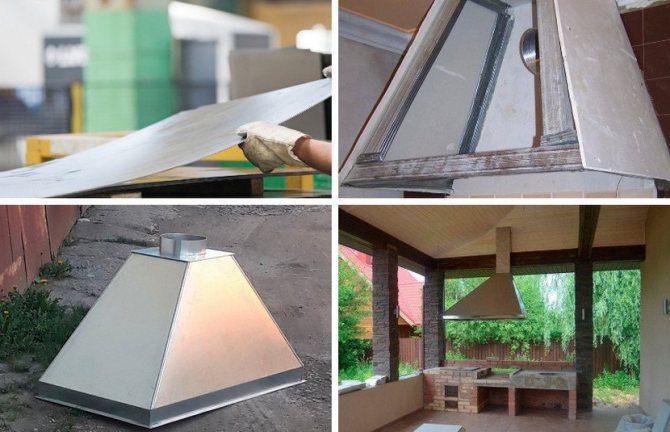

Hood for barbecue in the gazebo
This attribute of outdoor picnics can be portable and stationary. Portable barbecues, very simple designs, do not need hoods. The owners can easily place them anywhere, so that the smoke does not go towards the recreation area, and does not interfere with the guests. But stationary barbecues need a smoke extractor, especially if they are located inside the gazebo or in the summer kitchen.
There are two main types of brazier hoods: metal and brick. The first are the most widespread. They are easy to make with your own hands, you can hang or install them on supports above a brick oven, the choice of shapes and sizes is very large. Brick hoods, in fact, are an integral part of the barbecue oven, on which you can cook not only barbecue and grilled vegetables, but literally anything. Laying out a brick hood, which will become the beginning of the chimney, is already a matter for the master, the stove-maker.
Therefore, we will focus on metal exhaust hoods, which can be in the form of a hemisphere, parallelepiped, or a cut pyramid. Such domes for barbecues are made most often from stainless steel sheet with a thickness of 2 millimeters. Factory products are covered with a protective polymer layer; at home, the metal can be simply painted to give the hood a more attractive look and extend the service life.
The design of the simplest metal hood is not complicated:
- Smooth rectangular base;
- The dome is on it;
- Chimney pipe.
The size of the dome will depend on how large your grill is. In order for the umbrella to remove all combustion products, soot and sparks, it must be 30 percent larger than the size of the barbecue. And the pipe should be located exactly in the center, above the hearth!
We give you the standard parameters of an exhaust hood:
- The width of the smoke box, dome - from 65 to 95 centimeters;
- The length of the smoke box is from 85 to 155 centimeters;
- The height of the pipe is not less than 300 centimeters, which will ensure normal traction in any weather;
- The pipe section is at least 25 centimeters, also for good traction.
You can increase or decrease these standard sizes of the smoke collector-umbrella depending on the features of your barbecue. But we do not recommend reducing the height and diameter of the chimney pipe!
The manufacture of a metal barbecue is associated with welding and flexible steel, but in general it does not represent anything complicated, a home craftsman can do it quite well. You can supplement the exhaust hoods with a fan so that the draft appears immediately after the firewood or coal is ignited, without waiting for the smoke to heat up and begin to go into the chimney in a natural way.
A spark arrester, which is installed on top of the pipe under the chimney hood, will also not interfere. Some people put a removable grease trap inside the hood, which will have to be cleaned regularly. However, this process is familiar to all owners of conventional kitchen hoods. All of these additions will increase the cost of the hood, but make the cooking process safer and more convenient. published by econet.ru
If you have any questions on this topic, ask the specialists and readers of our project here.
How to make an umbrella on a chimney with your own hands
Before manufacturing, the diameter of the chimney is necessarily measured, and the step-by-step manufacturing technology for such a structure is as follows:
- cut a tin strip 70-80mm wide and length depending on the diameter of the chimney with the addition of a small margin for fastening;
- on a caliper, draw the strips with an indentation of 10 mm from the edge of the tin strip;
- hammer through the rails in accordance with the marked stripes, which will allow you to easily and evenly fold the workpiece;
- make four parts according to the strip marks, tap, make a right angle, wrap and finally punch with a hammer;
- prepare a cardboard round patternthe diameter of which exceeds the size of the chimney by 150 mm;
- cut out a tin circle for the umbrella in accordance with the prepared template and cut out an angle that allows assembly in the form of a cone.
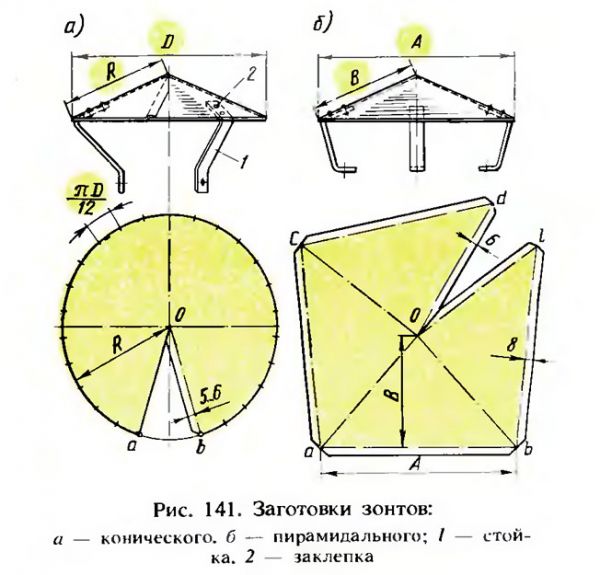

DIY umbrellas
The finished umbrella must be riveted in a couple of places, after which it is required to attach three reinforcement strips or so-called racks to the structure.
IMPORTANT!
The easiest way to improve the appearance of the finished structure is to beautifully design the edges.... For this purpose, you can make metal cuts along the edges and slightly bend the resulting "petals" or bend the wave-like cut edges.
Features and Benefits
A gazebo with barbecue will make cooking in the fresh air a truly restful, comfortable and relaxed one. Its huge advantage is that an unexpected change in weather, insects will not spoil it. The gazebo will be able to protect a large number of people from bad weather. And if the interior, for example, provides for a resting place with a rocking chair, a hammock, then many guests are definitely provided for the owner of this miracle.
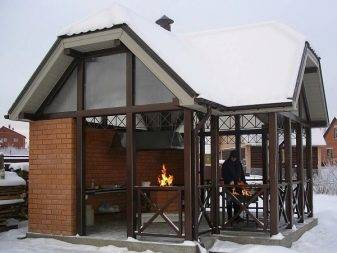

Gazebos can be temporary or permanent.
Temporary gazebos are installed directly in the warm season, by the onset of cold weather they are dismantled and stored. As a rule, they are used by summer residents whose stay on the site is seasonal. The advantage of this option is the ability to move them, the ease of construction.
Permanent gazebos are installed on asphalt pavement, piles or strip foundations, depending on the type of soil and the severity of the structure. Even in winter, such a gazebo can be used for its intended purpose. The size of permanent gazebos can be quite large, it all depends on the desires of the owners. Often full-fledged kitchen and dining areas, a resting place are arranged there.
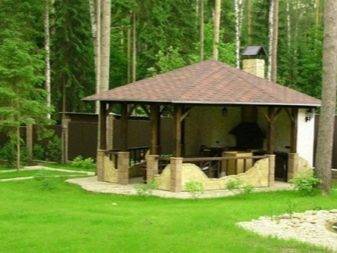

The most important attribute in such a gazebo is a barbecue, on which any dish turns out to be tasty and aromatic. The chimney is the key design element here. The presence of this design is necessary even if the gazebo is open. The chimney removes smoke and soot from the gazebo space and brings them out.
The smoke collector for the barbecue in the gazebo can be made of brick or metal. It is better to make metal hoods from stainless steel; there is practically no need to care for it.
Brick chimneys are more difficult to assemble, heavier and more expensive, therefore they are rarely used. They are used mainly for brick arbors, in case there is a desire to withstand the entire building in a single style. In small buildings, due to their heavy weight, their use is highly undesirable.
A fairly common option for a gazebo is a folding brazier. During the cold season, gazebos are usually open, and the coatings inside are exposed to the weather. The brazier suffers from them quite strongly.
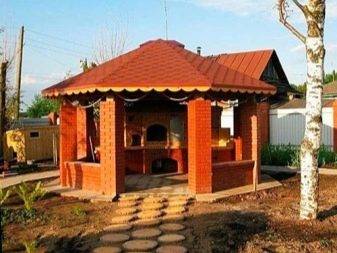

When organizing a hood in a gazebo, the following difficulties most often arise:
- The smoke does not leave the gazebo. This is usually due to the low combustion temperature.This problem can be corrected by increasing the temperature in the hearth - the smoke heats up, its density changes and it begins to rise and go into the chimney.
- Combustion products accumulate in the gazebo. This is due to the insufficient length of the smoke collector pipe. The top of the pipe must be at least 3 meters above the ground. In other cases, the draft is not enough, smoke and soot remain in the room.
- After heating the wood to a sufficient temperature, the smoke does not go away. In this case, we can already talk about the wrong size calculation. The diameter of the outlet pipe must be at least 15 cm, and the section of the chimney itself must be a square with a side of at least 26 cm.
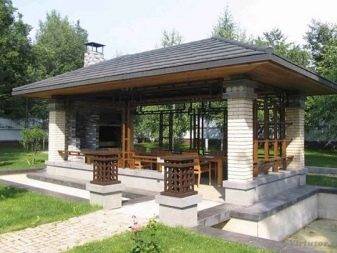

It is desirable that the gazebo is warm and protected from the weather as much as possible. Such structures can be open and closed.
At the open gazebo, the walls are low, the roof rests on racks of various types. In case the weather worsens, they can be provided with PVC curtains or a film, reinforced as roll-curtains on the openings. In the event of a cold snap, they can be lowered and the space inside from the wind and rain can be closed. A closed gazebo is a small house with a door and walls. The walls can be movable and fold in good weather.
There are times when the means or the size of the gazebo do not allow organizing the hood for the barbecue. This issue can be solved by placing the hearth outdoors.
In addition to a barbecue or barbecue, an open hearth can be equipped in the gazebo. It can be used for cooking, boiling, or braising in refractory cookware.
It is good if a comfortable firebox is equipped next to the gazebo. It is better to close it with a canopy or make it in the form of a special box with a lid.
Fire safety must be provided in full. The distance from wooden residential buildings to a gazebo with barbecue facilities should be at least 8 meters. Electrical appliances must be grounded, only a special outdoor cable can be used. If there are elements made of wood in the gazebo, they must be treated with fire retardant compounds against fire.
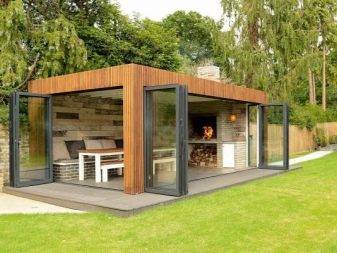

Components
Any cooker hood consists of an umbrella and a chimney. It is recommended to add a grease trap and a smoke extractor (electric draft fan). The most common design is made of a metal hanging umbrella and a chimney. It provides complete freedom for the barbecue and is quite cheap. Where the brazier stands against the wall or heavy material is selected (for example: brick), the umbrella rests on 1, 2 or 3 walls. In the latter version, the brazier is very similar to a fireplace.
Umbrella
The hood is needed to collect air over the barbecue with smoke, grease and fumes. The most accessible material for an umbrella is sheet metal. The weight will be small.
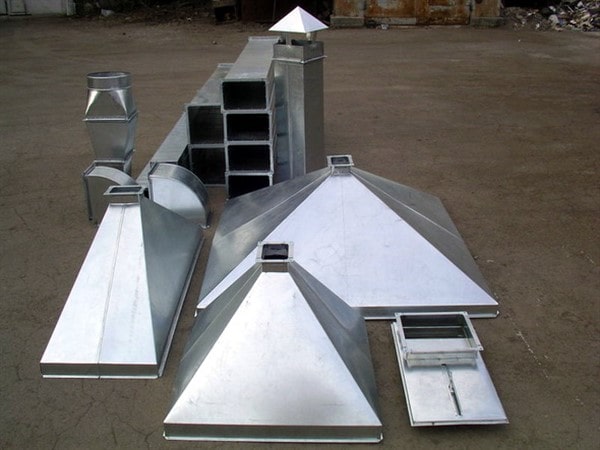

The metal umbrella can get very hot. Be careful.
If the umbrella is made of brick or rubble, the inner surface should be without ledges and smoothly converge to the chimney. The distance from the bottom of the hood to the brazier must be at least 75 cm.
5 cm flanging on the bottom of the umbrella increases the efficiency of the hood: it pulls from under the umbrella, and not from all sides.
For a confident suction of gases, it is recommended to make an hood with a forced chimney exhaust more than the area of the brazier by 20-30%.
The natural draft hood is demanding on the height of the pipe, the area of the channel and the size of the umbrella. The latter can exceed the size of the brazier by 5-8 times. Therefore, the option on passive traction is not recommended by us and is not being considered.
Chimney section
SP 7.13130.2013 5.8. The cross-section of chimneys (smoke channels) made of clay brick or heat-resistant concrete, depending on the heat output of the furnace, should be taken at least: 140 x 140 mm - with the heat output of the furnace up to 3.5 kW; 140 x 200 mm - with a heating power of the furnace from 3.5 to 5.2 kW; 140 x 270 mm - with a heat output of the furnace from 5.2 to 7 kW.
For a barbecue with a thermal power of 15 kW, a natural draft chimney with a cross-sectional area of 0.081 m2 is needed. Which means dimensions for a square chimney at least 285 x 285 mm, for a round one - a diameter of at least 321 mm.
For a hood over a brazier with a forced smoke extractor, the chimney cross-section must be at least the hydraulic diameter (D) which we determined in calculations and not less than according to SP 7.13130.2013 P 5.8.
Floor passage
Thin-walled iron or asbestos-cement pipes are very hot by combustion products and special heat-insulating layers are required for the passage of ceilings and roofs.
Brick pipes in the same places form thickenings, which reduces the temperature on their outer surface below the critical one.
The passage of ceilings and roofs for the chimney from special sandwich pipes does not require any additional unit. We recommend sandwich chimney pipes. This is a convenient compromise between cost, labor and safety.
The height of the chimney, according to fire safety rules, should not be lower than indicated in the photo.
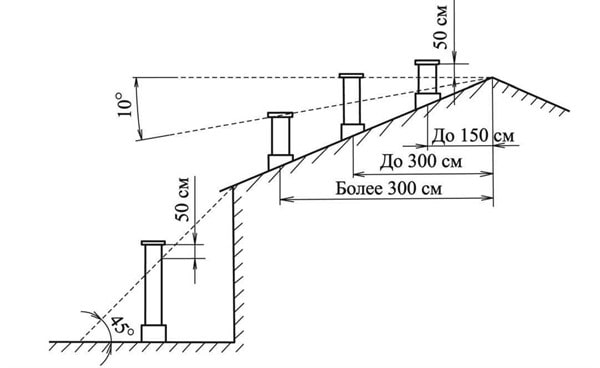

Chimney height above the roof and in relation to neighboring buildings
Fan (smoke exhauster)
An exhaust fan over the barbecue is required: without it, it is almost impossible to organize the required draft. Not any fan is suitable for hoods, they are also called duct fans. You need a high temperature or heat resistant fan.
What you need to pay attention to:
- Performance - the fan must provide a draft not less than the calculated one;
- Heat resistance - needs a high temperature fan;
- The seat is for round and rectangular ducts, the size should be suitable for the section of your chimney.
There are axial and centrifugal fans. Axial is more compact, but louder than centrifugal.
The fan is installed outdoors with a barbecue. This is due to the noise from its operation and the fact that the exhaust gases need to cool down.
Spark arrester
SP 7.13130.2013 5.13. Chimneys for wood and peat stoves on buildings with roofs made of combustible materials should be provided with spark arresters made of metal mesh with holes no larger than 5 x 5 mm and no less than 1 x 1 mm.
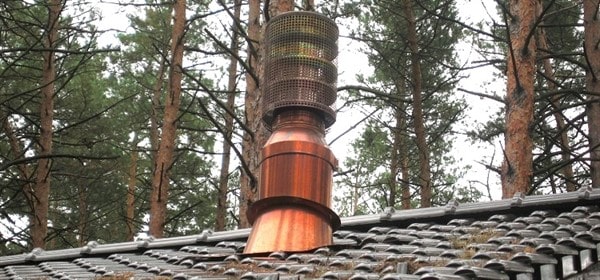

In our case, this is mandatory. Whatever the roof of a gazebo with a barbecue or a summer kitchen is: the plots are small, and there will definitely be some kind of structure nearby in dangerous proximity.
In addition to mesh spark arresters (spark arresters), there are designs in the form of a deflector:
Grease trap
The grease filter for the hood above the barbecue is an important and highly recommended addition. The grease trap protects the insides of the hood from fat, which means that soot and tar from the smoke will not stick to the fatty film.
The presence of a grease trap will not completely protect against soot settling on the inner surfaces, but it will greatly reduce such deposits.
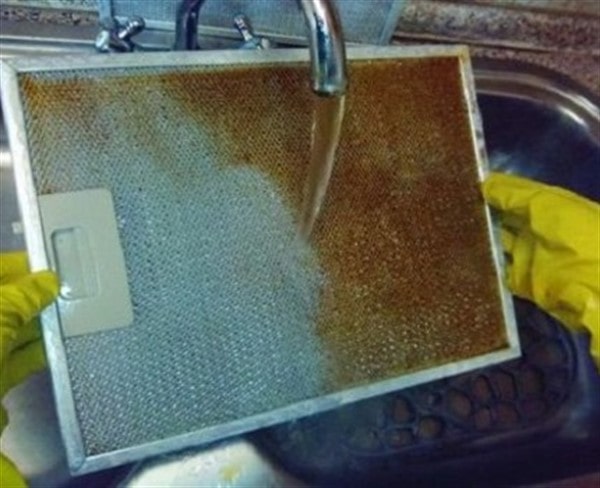

The grease trap is usually several layers of perforated aluminum or sheet metal or a complex labyrinth structure for professional hoods. Gas with a fatty suspension, getting into such a filter, settles in it. The grease trap is periodically washed using household chemicals against grease or dish detergents.
Fungus, deflector
SP 7.13130.2013 5.12. Chimney mouths should be protected from atmospheric precipitation. Umbrellas, deflectors and other nozzles on chimneys must not impede the free exit of smoke.
There are a lot of options for the deflector. There are options for combining a spark arrester and a deflector. There are even some that increase traction if there is wind, but the increase in thrust is small and in our case does not cause interest. Less resistance (if such a parameter is specified) and appearance - these are the 2 main selection criteria.
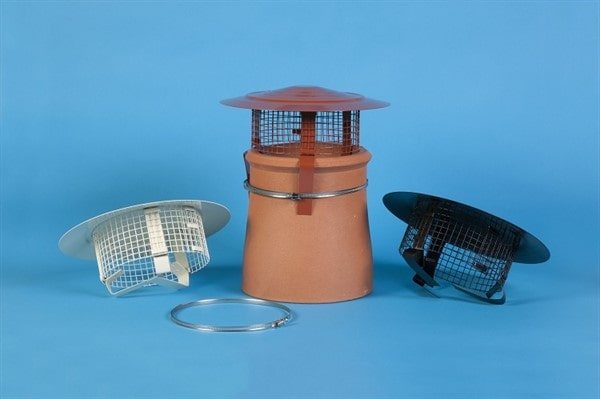

Interior decoration
The design of gazebos with barbecue is a matter of taste and capabilities of each owner.There are several recommendations, following which your barbecue corner will become a favorite place for the whole family and will decorate the site.
You need to start arranging the design of the gazebo with the idea of the structure itself, it should be harmoniously placed on the site.
The gazebo must be positioned correctly. To do this, they choose the most beautiful and quietest corner in the garden, far from prying eyes. This will allow its visitors to relax and unwind. The landscape and the summer kitchen should be compatible with each other.
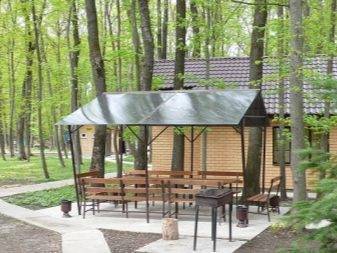

If we talk about the interior, then everything is more complicated here. The space inside must be beautiful, safe and functional at the same time.
When decorating a gazebo, the scope of imagination is unlimited. This is a great way to apply things that may have lodged somewhere in the attic. For example, a horn on the walls or an old samovar can become interesting interior elements. Anything can become a beautiful element: curtains, forks hung on the wall near the barbecue, shovels and grabs for meat, jars with spices, flowers on the table.
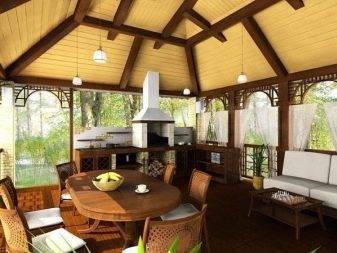

Lighting is an important element of any interior. The cooking area should be lit most brightly, and soft dim light is suitable for the relaxation area. It's good if the light level is regulated.
Design of the cooking area. The key element of this area is the oven. Depending on the size of the gazebo itself, the content of this zone will be different. For a small gazebo, it is possible to install a small table with a hand basin. The worktop material should be easy to clean and durable. It is convenient if there is a small shelf next to the barbecue where you can put seasonings, put the most necessary appliances.
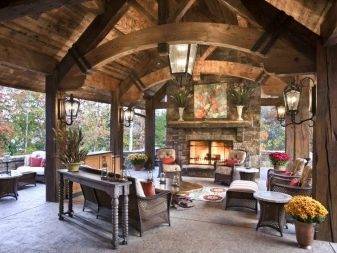

If space permits, you can make a lounger in the gazebo or hang a hammock in a secluded corner. The space next to the gazebo is equipped as much as possible. For example, you can pave the area under an additional canopy in case of an increase in the planned number of guests. You can install a large garden swing with a roof, which will become a favorite place for children and adults. For children, you can also arrange a sandbox or soft playground for active games. Here, the master's imagination can be unlimited.
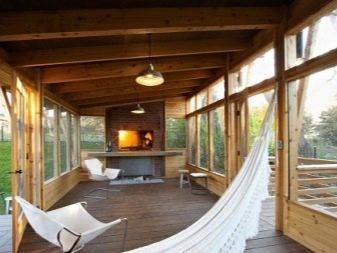

The very material of the gazebo can contribute to the creation of coziness. Here the tree will be the undisputed leader. Mats made of straw or other natural materials can be used to complement it. In a closed gazebo, you can use any kind of textiles: large interior pillow-chairs, soft bedspreads. It should be noted that the size of the gazebo affects the coziness - the smaller it is, the more comfortable it is for a person, as a rule.
All materials must be suitable for outdoor use or handled appropriately. Also, they should all be easily cleaned, since staying in the gazebo is associated with eating.
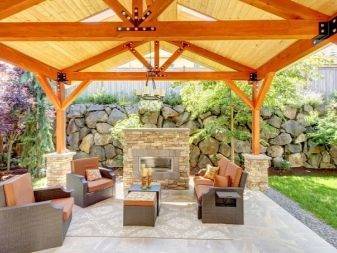

The most common and pleasing to the eye is the use of natural colors of the natural range. The gazebo should not be striking with its brightness or pretentiousness - it will quickly get bored.
The style of the gazebo is often chosen based on the preferences of the owners or from what is at hand. The Asian style involves intricate flattened roofs with multiple levels of flooring inside. Country style works well for wooden buildings. The English style with forged elements will appeal to lovers of elegance and sophistication.
When deciding on the idea of \ u200b \ u200bdesigning the entire gazebo and its interior in particular, one must not forget that this is an auxiliary structure, and unnecessary costs and difficulties in its construction are not necessary in all cases. And often they may turn out to be unnecessary and unnecessary and only make it difficult to stay inside and the process of cooking itself, which is the main one.
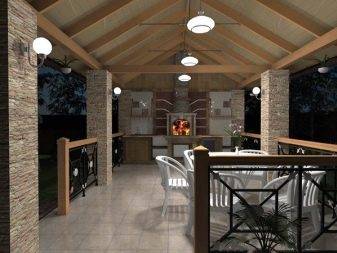

A few words about folding barbecue
The folding brazier is a lightweight brazier that can be easily moved and installed in the right place, including in the gazebo.The best material for its manufacture is stainless steel, the optimal wall thickness is two millimeters.
Thinner sheets will quickly burn out, thicker ones will significantly increase the weight of the structure. To improve the combustion process, through holes are made around the perimeter of the lower part of the brazier. Through them, coals can fall onto the floor of the gazebo and ignite it.
In addition, the folding brazier is easy to tip over, so you need to use it very carefully.
Benefits
However, a folding brazier has certain advantages. These include:
- small weight for easy transportation;
- when disassembled, the brazier easily fits into the trunk of a car;
- low cost.
A big plus of a folding barbecue is the ability to use it without arranging a hood.
A small brazier does not generate much smoke when cooking meat. As a rule, a folding brazier is installed in gazebos, which are a canopy without walls. In closed gazebos, it must be equipped with an extractor hood.
Why build a chimney
Many lazy inhabitants do not see the point in arranging a chimney for a barbecue in a summer gazebo. They rely on the wind to blow smoke out from under the canopy, but in reality this is not happening. One has only to start frying the meat - the whole gazebo is covered with clouds of smoke, and if there is an exhaust hood, it is removed outside.
If you do not do it, then after using the barbecue, a layer of soot and soot will settle on the ceiling, which is extremely difficult to clean. If you often fry meat on such a grill, the kebab will be seasoned with soot crumbling from above.
In addition, a fireplace with an open flame that is not equipped with a hood is a fire hazard.
Some notes and recommendations
Any hood, including hand-made devices, has certain disadvantages that should be borne in mind in advance, so that later you do not have to re-install.
The barbecue fan is mounted after masonry using special bricks and clay mortar. The bricks should be laid flat on top of each other. The chimney must be provided with a shutter, the rear wall must have a bend to provide improved draft.
If you need to light the brazier, then the smoke will not go straight into the smoke box. At first, the device smokes in different directions. The smoke generated during ignition can have a fairly low temperature level. The moment the flame flares up, the thrust will become stable.
After the flame has ignited, the smoke collector may not be able to cope with the elimination of smoke, that is, the barbecue woman smokes at the same time. This sign indicates that the chimney has a small cross section. Since he must cope with his functions without problems, the dimensions of his square section must be at least 26x26 cm.
The best aerodynamics of a vertical metal pipe is ensured only with its narrower cross-section, the diameter of which is about 15-20 cm. Since the smoke coming out of the pipe begins to interfere with the cooking process, the upper part of the chimney should be at least 3 m above the ground. Then there will be enough thrust, and the smoke will be removed to the required height, and then dispersed in the air.
Exhaust hood design
A metal hood can be thought of as a smoke collector or a domed smoke hood. The fixture has a hole in the center and a barbecue pipe. The dome design is a smoke hood or exhaust hood. Its diameter should be 1.5 m. A popular material for creating a dome-shaped device is a metal sheet, which is 2 mm thick.
Copper hoods have a rather impressive look.The center of the dome of the device is equipped with a hole with the edges connected to a vertical pipe, the height of which is 2-3 m. Do not use asbestos-cement pipes to create a hood with your own hands. Although asbestos is a flame retardant material that has excellent thermal insulation properties, it is hazardous to health.
Rack-mounted metal hoods are suitable for barbecues and are becoming more and more popular. If a brazier, grill or barbecue is installed in a gazebo, then the hood is suspended from its ceiling on chains. In this case, the pipe usually passes through the center of the gazebo roof.
The material that is adjacent to the chimney must be fireproof. To create a hood, you will need experience with a sheet of metal. The device does not have to be domed. You can order the manufacture of hoods from professionals.
A do-it-yourself smoke collector made of metal can have not only a cone-shaped shape, the cross-section is rectangular or square. The device is functional, but requires constant maintenance. Its smooth surface makes it easy to care for. It should be good at removing smoke, having aerodynamics.
Owners of gazebos, which are lined with brick smoke collectors, claim that a rusted metal hood can contaminate food. When the stove smokes, soot and rust can drip onto the food being cooked. Brick hoods are durable.
Umbrella design
The exhaust ventilation is a simple device. Accuracy is important in manufacturing, therefore it is recommended to use a drawing. The umbrella consists of 3 parts, each of which serves for the phased removal of smoke:
- Smoke box, or chimney. The task of this element is to collect all volatile compounds from the frying plane in one pass of a narrower section. For rectangular and square barbecues, the classic shape of the smoke collector is a truncated pyramid: 4 sides tapering towards the top. For devices with a round firebox, the collector is a cone.

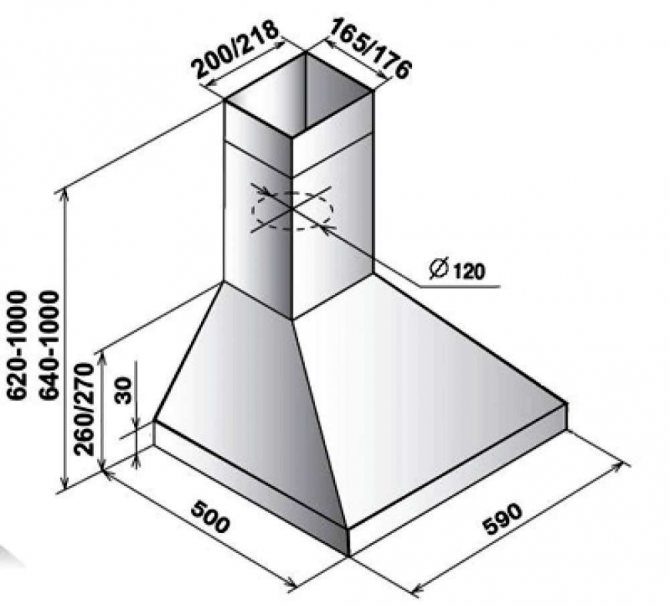
- A pipe, or, in fact, a chimney. The function of this element is to raise the collected smoke to a given height. As a rule, 3 meters above ground level is enough: this is higher than the height of a person and does not allow combustion products to descend in the wind. The shape of the pipe depends on the collector: rectangular section - for a pyramidal nozzle, round - for a cone. The main thing is to tightly connect the internal volume.
- An umbrella is a small but important element. Installed above the chimney at a height of 10-20 cm and protects the chimney from precipitation without interfering with the removal of combustion products.
Brick umbrellas
Brick umbrellas are built over static barbecues, since they are much more durable than metal ones. In addition, they have an attractive appearance that will look great on any landscape design.
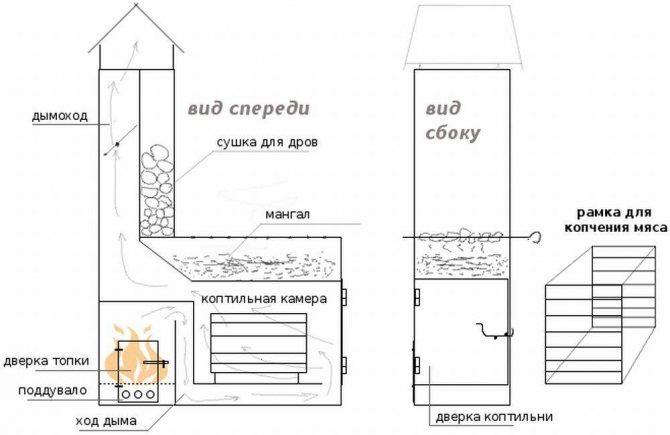

Diagram of a brick umbrella.
To build such an umbrella, you can use either oven brick or fireclay. Moreover, the area that is laid out strictly above the brazier is made only of refractory (chamotte) bricks, and the chimney itself can be made with a stove. Seams should be sealed with clay mortar. For this, it is advisable to use clean clay diluted with water to the consistency of sour cream. Less often, sand is added to the solution, but it should not exceed 50% of the clay mass. Before starting work, the brick must be soaked in water so that the water completely covers it. After pouring the bricks, they are left to "get wet" for 2-3 hours. This is done so that the bricks do not absorb water from the solution, otherwise the structure will collapse after a while.
Before starting work, you should assemble the frame, which will be the base for the dome. It is welded from a wide steel angle, which must be primed and painted after welding.
After welding, it is necessary to wipe the welded seams with sandpaper or a file in order not to trim the brick in the future. The welded frame is installed above the brazier on the supporting walls (there should be a minimum of 2, a maximum of 3). For its installation, reinforcement tabs should be provided - to ensure the strength of the structure, a frame is welded to them. Laying bricks begins to be done around the perimeter of the frame. Moreover, such a hood should not have a large area - the frame may not withstand. Most often, the hood is made in a stepped shape, while the outgoing chimney can be metal. Sometimes after laying the hood, the edges are rounded to improve the appearance.
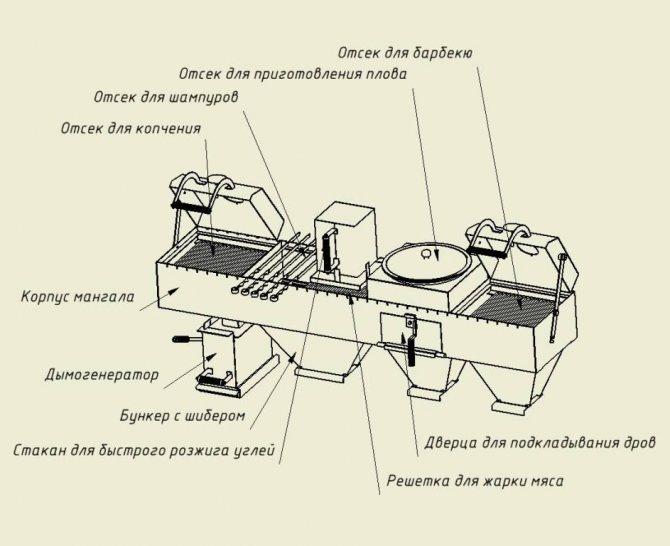

Barbecue device diagram.
After the hood is folded, it is given several weeks to dry, otherwise the wet mortar will collapse and destroy the structure. After 2 weeks, the structure is inspected and the seams are checked for moisture (one of the options for checking is to attach tissue paper to the seam and leave for a while). After the solution has dried, a test run (short-term) is carried out.
A brick cooker hood provides a comfortable stay at the grill when barbecuing. Such umbrellas have the following advantages:
- Good draft resulting in no smoke from the brazier.
- Stronger construction (compared to metal umbrellas).
- Longer service life.
- Maintainability.
The disadvantages include:
- Large weight of the structure, which requires the creation of a full-fledged foundation under the barbecue.
- The complexity of the construction of such a dome.
- Much higher cost of work and materials compared to metal umbrellas.
Nuances of operation
I would like to pay special attention to firewood, which is recommended to be used in the process of cooking various products. So:
- seafood and poultry - oak, grapevine;
- lamb, pork, beef - apple tree;
- turkey or salmon - alder;
- pork, poultry, seafood - maple;
- chicken, beef - birch;
- lamb, poultry - cherry.
Video: tips on how to properly stack firewood in the grill
Each type of wood will add a special taste and unique aroma to the prepared dish. Experts do not recommend using conifers for kindling, since resins can be released during combustion. If it is not possible to prepare firewood on your own, then you can buy briquettes with ready-made charcoal in almost any supermarket, which, moreover, perfectly keep the heat necessary for cooking barbecue.
Metal hood
The easiest and cheapest way to make an umbrella is from metal. To do this, you can use the following materials:
Stainless steel. The best option for such structures, especially if the grill will be constantly outdoors. You can buy stainless steel sheets at almost any hardware store. Large diameter stainless steel pipes are suitable, which are cut to length and unbend. The main drawback of such material is the price.
Stainless steel can attract the attention of "metal hunters", so it is recommended to paint it. Galvanized. It is less durable than stainless steel, but cheaper
The disadvantages of galvanizing include the fragility of the coating, which over time will lead to the destruction (rusting) of the entire structure. Steel. The cheapest material. However, before starting the installation (after making the hood), it is necessary to apply a protective coating - a primer and paint. In this case, the condition of the protective coating should be constantly monitored, and in case of damage it will have to be primed and painted again.
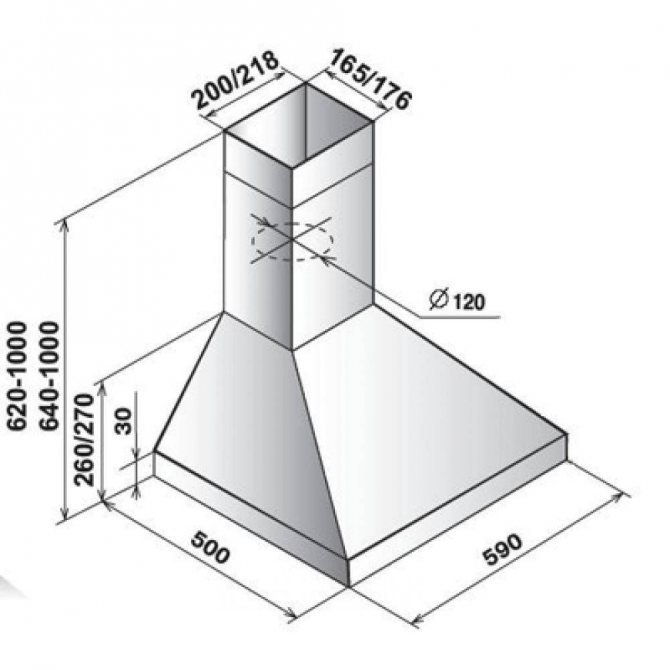

Diagram of an umbrella for a barbecue made of metal.
Regardless of what kind of metal was chosen, it will not affect the shape of the structure. As standard, all hoods are domed with a chimney opening in the center of the dome.
At home, to make such a hood with your own hands, you need a welding machine. The easiest way to make a trapezoidal umbrella. For this, 4 identical trapezoidal parts are cut out. They are welded to each other with side faces, after which the upper, narrower hole is closed with a cut-out square element, in which a hole is made in the center for a chimney. The pipe itself is bought ready-made, it is welded to the exhaust hole, after which the lower part of the dome is strengthened by welding thin reinforcement around the perimeter. The size of the trapezoidal parts to be cut depends on the extrusion parameters. In this case, the length of the base of the trapezoid should be such as to ensure the flow of smoke from the barbecue. Installation is carried out strictly above the brazier.
The metal hood is installed on stone / brick supports (if a brazier is made of them) and fixed (cemented). Another way is to lay the fittings of the required length when building a brazier and weld an exhaust hood to it. Such a hood can be installed over a portable metal brazier: for this, fittings are welded to the brazier in the corners, onto which the hood is welded. However, this is not advisable as it will reduce (or even negate) portability; in addition, the effect of such a hood will be negligible.
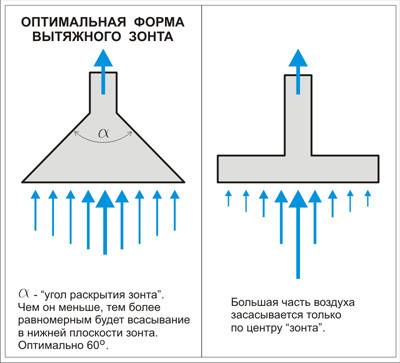

Optimum hood shape.
After the first launch, patterns may form on the metal, they will be especially noticeable on stainless steel. You should not be afraid of them - they do not affect the life of the hood and do not spoil the quality of the metal.
Such hoods have the following advantages:
- Material availability.
- Ease of manufacture.
- Fast and easy installation.
- Low cost (compared to the rest).
- Renovation and easy maintenance.
- Attractive design.
Views
All existing kitchen umbrellas differ in several ways:
| Appointment | Can be household and industrial |
| Installation method | There are wall and island. |
| Form | They can be rectangular, square or round. |
| Device | As mentioned above, different models may have some structural differences. |
Next, let's take a closer look at the features of each type of these devices.


Household ventilation round umbrella
Household and industrial hoods
An industrial ventilation hood is in many ways similar to household hoods.
The difference is only in a few points, such as:
- Size - industrial devices are much larger, as they cover the area of industrial furnaces.
- The fan power is much higher.
- Filters - industrial hoods have special grease traps, from which the settled impurities drain into a special glass. Such a drive must be periodically emptied and washed with soapy water. Household devices, as a rule, have paper and fibrous disposable filters.
I must say that the difference between industrial and household hoods is sometimes not very pronounced. For example, in cottages, devices are often installed that are very similar in their characteristics to industrial hoods.
Note! The price of these products mainly depends on the fan power, dimensions and the availability of additional functions.
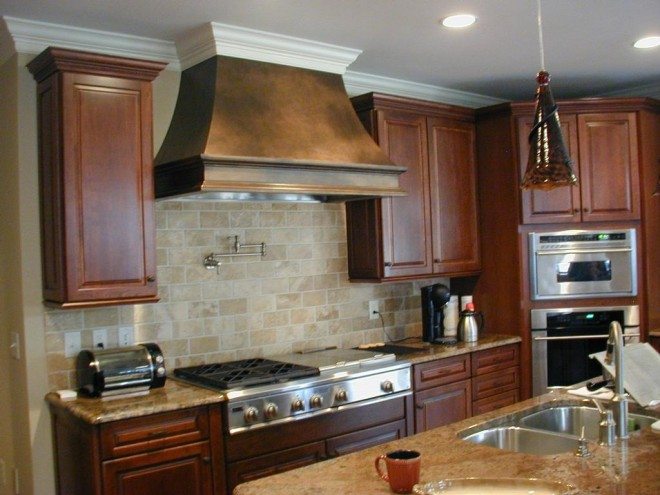

Wall-mounted construction
Installation methods
As mentioned above, there are two types of hoods according to the installation method:
- Island ventilation umbrellas - suspended from the ceiling. They are often installed above the stoves located in the middle of the room. As a rule, such devices contain several rows of filters.
- Wall-mounted - as you might guess from the name, they are mounted to the wall. Such structures are often installed above kitchen stoves located near the wall. It is quite simple to install such a hood with your own hands.
Note! When installing the hood above the stove, according to GOST for the hoods of ventilation systems, it must be at least 100 mm larger than the hood. This will avoid the release of harmful substances into the environment.
Here, perhaps, are all the main differences between local exhaust installations, knowing which, you can choose the most suitable device for a particular case.
Brick hood
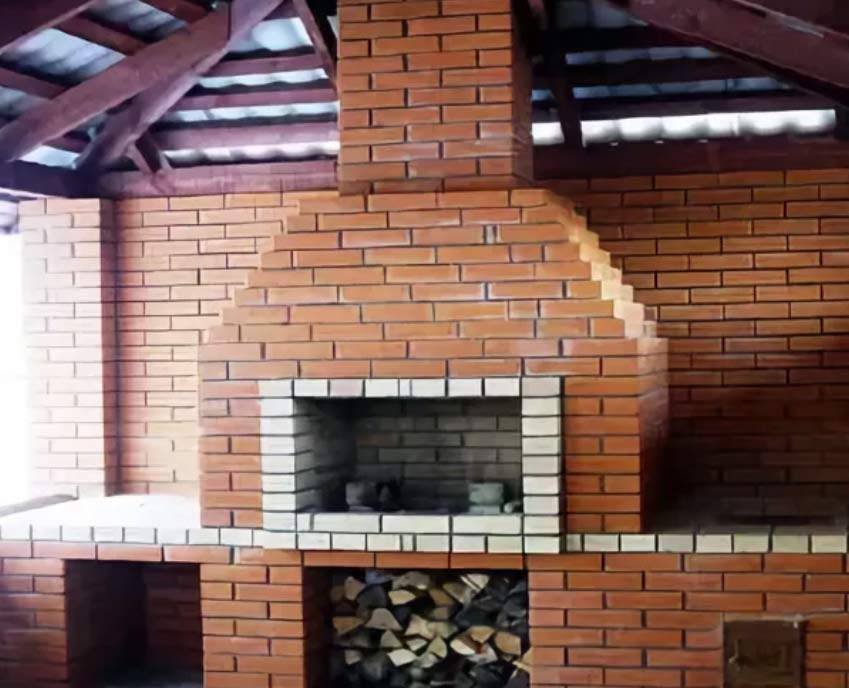

Brick barbecues are becoming more and more popular. They have their own merits. It is a monumental, durable structure. With the right device and the skill of the master, such a grill will delight and decorate the territory for many years.
Advantages of a brick hood:
- Durability;
- Low heating of the brick surface;
- Aesthetic appearance, with the help of a brick grill with an exhaust hood, you can create a practical architectural miniature on your site;
- Combines the functions of a brazier and a cooker hood.
Making a brick hood
If you wish and have good experience in construction, you can build a brazier with a brick hood with your own hands. For this you will need:
- Brick;
- A mixture for laying bricks, or a mortar of clay and sand, in a ratio of 7 parts of clay to 3 parts of sand;
- Metal corners, to simplify the installation of the hood;
- Masonry tools, for cutting and welding metal corners.
Important: for the construction of a hood and a barbecue bowl, use only refractory bricks (chamotte) and mixtures. Otherwise, under the influence of high temperatures, the entire structure will collapse.
Instead of a heat-resistant mixture, it is permissible to use a solution of clay and sand.
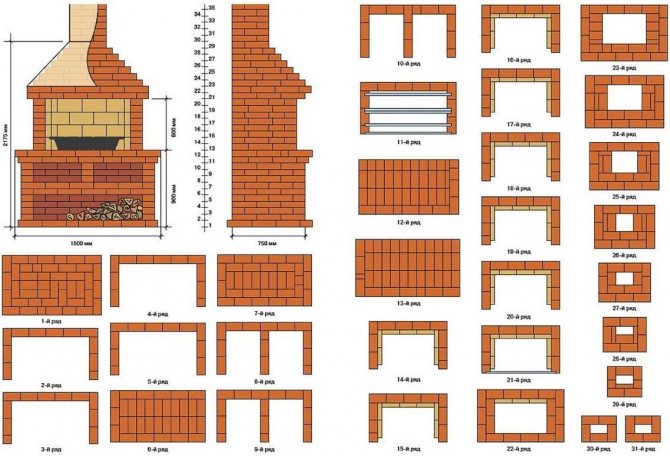

Installation sequence:
- Mark the position of the hood, not forgetting that it should be larger in size and volume of the barbecue itself;
- First, the supporting walls are laid out on which the smoke collector will lie. Back and two side;
- A metal frame from the corners is installed on the brick supports. By analogy with a metal hood, it also has the shape of a truncated pyramid. First of all, the lower part is welded, then the upper narrowed part of the frame, and they are connected by corners, also by welding. For the convenience of masonry, you can assemble the chimney frame from the corners by welding it to the hood frame;
- The finished frame is lined with bricks. The first row is exposed with a brick perpendicular to the rear support wall, the second and subsequent rows are placed in parallel, with an offset of 17 mm, creating the necessary pyramidal shape;
- The chimney is laid out on the frame or without it, subject to the minimum internal diameter of 120 mm;
- Install an umbrella cover to protect from precipitation.
Problems that may arise in the process
There are no products that are completely perfect - everything has flaws. Several problems emerge from this, which we will consider below:
The biggest problem is if the smoke does not go into the hood, but diverges to the sides. This only happens if you have not taken care that the ventilation is equipped with a fan. They are usually electric and can be turned on as soon as you start working with the barbecue. Although, as a rule, smoke can remain in the room also because it simply did not have time to heat up and its density is the same as the density of air. Therefore, as soon as the smoke heats up, it can independently go up and go out through the ventilation pipe. The chimney cross-section is about 25-27 cm. What if this is not the case? Nothing special, just smoke cannot be absorbed in full.
By the way, it is also very important that the pipe is about 16 cm in diameter. Also, do not forget that the height of the pipe must be at least 3 meters from the ground. Only in this way the smoke will completely come out and disperse.
The rest is simple. Assemble the exhaust hood as shown in the drawing above and weld it to the pipe. After - just attach the product in the right place.
Of course, you can also build a brick hood, but, firstly, it is only suitable for brick barbecues, and, secondly, this design is much more complicated.
Output
Exhaust hoods are widely used in everyday life and in the food industry, as they provide high-quality removal of polluted air. In addition, the instructions for their operation and maintenance are extremely simple. The main thing is to choose the right device for each individual case, especially for industrial devices.
From the video in this article, you can gather some additional information on this topic.
Did you like the article? Subscribe to our channel Yandex.Zen
Types of smoke exhaust structures
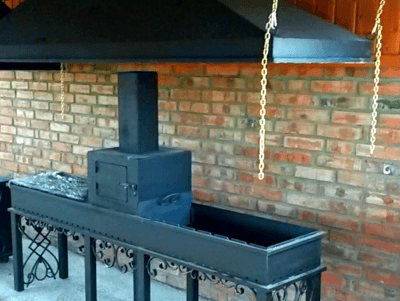

The types of smoke exhaust structures and materials for their manufacture are not very diverse. In gazebos of all types, chimneys for the barbecue are made of metal or brick. Brick structures are mainly used in stationary barbecues made of the same material.
They look very attractive, but it is rather difficult to clean them properly, and sometimes it is simply impossible. To build a brick chimney, you must have the skills of a bricklayer, in addition, the cost of such a structure is much higher than that of a metal product. Therefore, zealous owners most often prefer to build a metal hood over the barbecue.
Metallic
Chimneys made of metal have the following advantages:
- do-it-yourself assembly availability;
- ease of installation;
- low weight;
- smoothness of the inner surface;
- ease of cleaning;
- the ability to give the product any shape.
Almost any home craftsman with the skills to work with power tools and welding equipment can assemble a metal chimney.
In the absence of a welding machine, the structural elements can be bolted. The metal hood does not create a serious load on the base of the gazebo, its walls have a smooth surface, on which, unlike brickwork, soot contamination does not stick. If you need seasonal use or transfer to another place, the structure can be easily disassembled. It can be painted in any color with heat-resistant paint.
What are the hoods
An exhaust hood for a barbecue is most often used for closed-type gazebos, where there is a special stationary brazier. Basically, such gazebos are built of wood, sometimes with panoramic windows.
The hood for the barbecue in the gazebo is necessary for fire safety purposes, it eliminates sparks, odors, and so on. There are such options:
- metal hood;
- brick hood;
- portable.
The metal structure is very popular, since it can be purchased ready-made. You can design this type of exhaust hood yourself, but you can also resort to the help of specialists who will make this design individually, according to your dimensions. A brick hood is of a rather complex design; it is built for stationary use.
A portable hood is a simple option. It is perfect for cases when the weather is rainy, and you don't want to place your barbecue in the yard or gazebo, since everything will be filled with smoke. In this situation, you will need a portable hood.
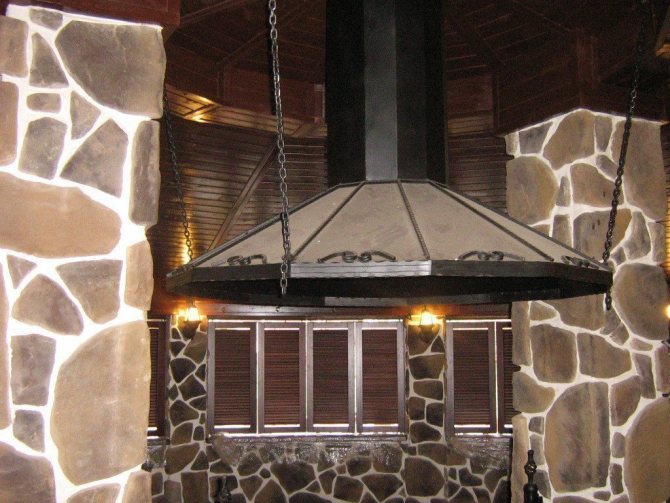

The hood for the barbecue is easy to do with your own hands
Having dealt with all types of hoods, it would be reasonable to ask the question: how to make a hood for the barbecue with your own hands? This is the next section of our article.

